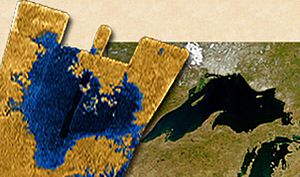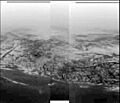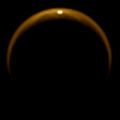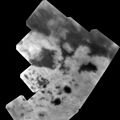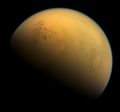Lakes of Titan facts for kids
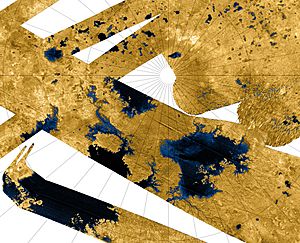
The lakes of Titan are amazing bodies of liquid on Titan, which is a large moon of Saturn. Unlike lakes on Earth, these lakes are not made of water. Instead, they are filled with super-cold liquid methane and ethane.
Scientists first thought Titan might have liquid on its surface after the Voyager 1 and Voyager 2 probes flew by. They saw that Titan had a thick atmosphere, which could support lakes. Later, in 1995, the Hubble Space Telescope and other telescopes gave more clues.
The Cassini-Huygens space probe was sent to explore Saturn and its moons. When it arrived in 2004, scientists hoped to see reflections from liquid lakes. At first, they didn't find any.
Contents
Discovering Titan's Lakes
Scientists still believed that liquid ethane and methane would be found near Titan's poles. This is where they expected to find a lot of liquid.
First Discoveries
At Titan's south pole, a large dark area called Ontario Lacus was the first lake identified. It might have been formed by rain, as clouds are often seen there. Radar images also showed a possible shoreline.
On July 22, 2006, the Cassini-Huygens probe flew over Titan's northern part. This area was in its winter season. The probe's radar took pictures of many large, smooth areas.
In January 2007, scientists announced they had "definite proof" of methane lakes on Titan. The Cassini-Huygens team decided these smooth areas were the hydrocarbon lakes they had been looking for. These were the first lakes found anywhere in space besides Earth! Some valleys even looked like they had rivers.
More Evidence
The Cassini-Huygens probe flew by again in February 2007. It took radar and camera pictures of large areas near the north pole. These areas seemed to be huge bodies of liquid methane and ethane. One "sea" was bigger than Lake Superior on Earth. Another was similar in size to the Caspian Sea.
In October 2007, pictures of Titan's southern pole showed smaller areas that also looked like lakes.
Chemical Proof
In December 2007, the Cassini-Huygens probe flew very close to Titan. It took infrared pictures to study the chemicals on the surface. It found a lake called Ontario Lacus near the south pole.
Scientists confirmed that one or more of the large lakes on Titan held liquid. This liquid was made of hydrocarbons, including ethane. This mission proved that Titan is the only other place known in our Solar System to have liquid on its surface.
The lakes make Titan very important for studying weather science. Liquids, gases, and temperatures all play a role on Titan. This helps us understand weather better, even on Earth.
What About the Equator?
Lakes were not found near Titan's equator. The Huygens part of the probe landed there on January 14, 2005. The pictures it took as it fell showed no open areas of liquid. Instead, it showed rivers that had dried up.
At first, scientists thought a dark area near the center of Titan might be a lake or a tar-like substance. But the probe landed on this dark area and found it was solid. A device called a penetrometer studied the surface as the probe landed. It seemed to find wet clay. However, scientists now think the penetrometer might have landed on a large pebble. They say the surface is like sand made of ice. Pictures taken after the probe landed showed a flat area covered in pebbles. These pebbles might be made of water ice and are partly rounded, suggesting they were shaped by liquids.
Huge Hydrocarbon Reserves
On February 13, 2008, scientists announced that Titan's polar lakes hold "hundreds of times more natural gas and other hydrocarbons than all the known natural gas on Earth." Even the dry areas near the center of Titan have more organic materials than Earth.
In June 2008, Cassini's Visible and Infrared Mapping Spectrometer confirmed liquid ethane in a lake in Titan's southern half.
Scientists predict that during Titan's year, liquid moves from the equator to the poles. It travels in clouds and falls as rain, creating the lakes.
Names of Titan's Lakes and Seas
The large hydrocarbon seas on Titan are called maria (plural of mare). They are named after sea monsters from Earth's myths.
| Name | Latitude | Longitude | Diameter (km) | Source of name |
|---|---|---|---|---|
| Kraken Mare | 68.0N | 310.0W | 1,170.0 | The Kraken, a Norse sea monster. |
| Ligeia Mare | 79.0N | 248.0W | 500.0 | Ligeia, one of the Sirens, Greek monsters. |
Smaller liquid areas are called lacus (plural lacūs). They are named after lakes on Earth.
| Name | Latitude | Longitude | Diameter (km) | Source of name |
|---|---|---|---|---|
| Abaya Lacus | 73.17N | 45.55W | 65.0 | Lake Abaya, Ethiopia |
| Bolsena Lacus | 75.75N | 10.28W | 101.0 | Lake Bolsena, Italy |
| Feia Lacus | 73.7N | 64.41W | 47.0 | Lake Feia, Brazil |
| Koitere Lacus | 79.4N | 36.14W | 68.0 | Koitere, Finland |
| Mackay Lacus | 78.32N | 97.53W | 180.0 | Lake Mackay, Australia |
| Mývatn Lacus | 78.19N | 135.28W | 55.0 | Mývatn, Iceland |
| Neagh Lacus | 81.11N | 32.16W | 98.0 | Lough Neagh, Northern Ireland |
| Oneida Lacus | 76.14N | 131.83W | 51.0 | Oneida Lake, USA |
| Ontario Lacus | 72.0S | 183.0W | 235.0 | Lake Ontario, on the border between Canada and the United States. |
| Sotonera Lacus | 76.75N | 17.49W | 63.0 | Lake Sotonera, Spain |
| Sparrow Lacus | 84.3N | 64.7W | 81.4 | Sparrow Lake, Canada |
| Waikare Lacus | 81.6N | 126.0W | 52.5 | Lake Waikare, New Zealand |
See also
| The Solar System | |||||||
|---|---|---|---|---|---|---|---|
|
|
|||||||
| Sun • Heliosphere |
Planets ☾ = moon(s) ∅ = rings |
Mercury | Venus | Earth ☾ | Mars ☾ | ||
| Jupiter ☾ ∅ | Saturn ☾ ∅ | Uranus ☾ ∅ | Neptune ☾ ∅ | ||||
| Dwarf planets | Ceres | Pluto ☾ | Haumea ☾ | Makemake | |||
| Eris ☾ | |||||||
| Small Solar System bodies |
Asteroids (minor planets) |
Groups and families: Vulcanoids · Near-Earth asteroids · Asteroid belt Jupiter Trojans · Centaurs · Neptune Trojans · Asteroid moons · Meteoroids · Pallas · Juno · Vesta · Hygiea · Interamnia · Europa |
|||||
| See also the list of asteroids. | |||||||
| Trans- Neptunians |
Kuiper belt – Plutinos: Orcus · Ixion – Cubewanos: Varuna · Quaoar · Huya |
||||||
| Scattered disc: Sedna | |||||||
| Comets | Periodic comets and non-periodic comets Damocloids · Oort cloud |
||||||
| See also the list of solar system objects | |||||||
Images for kids
-
Picture of Titan taken during the Huygens landing, showing hills, rivers and beaches.
-
Intricate networks of channels drain into Kraken Mare (lower left) and Ligeia Mare (upper right).
See also
 In Spanish: Lagos de Titán para niños
In Spanish: Lagos de Titán para niños


